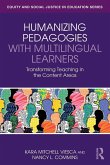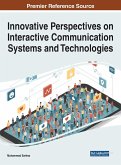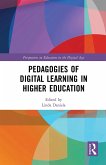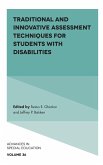Michelle Mukherjee (Queensland University of Technology), Christopher Blundell (Queensland University of Technology), Shaun Nykvist (Queensland University of Technology)
Supporting Innovative Pedagogies with Digital Technologies
Michelle Mukherjee (Queensland University of Technology), Christopher Blundell (Queensland University of Technology), Shaun Nykvist (Queensland University of Technology)
Supporting Innovative Pedagogies with Digital Technologies
- Broschiertes Buch
- Merkliste
- Auf die Merkliste
- Bewerten Bewerten
- Teilen
- Produkt teilen
- Produkterinnerung
- Produkterinnerung
Incorporating digital technologies in the classroom can be both a daunting and exciting experience for educators of all age groups. Supporting Innovative Pedagogies with Digital Technologies explores intentional teaching approaches for using digital technologies in the classroom as a tool to support rather than replace established strategies.
Andere Kunden interessierten sich auch für
![Innovative Jacquard Textile Design Using Digital Technologies Innovative Jacquard Textile Design Using Digital Technologies]() Frankie NgInnovative Jacquard Textile Design Using Digital Technologies151,99 €
Frankie NgInnovative Jacquard Textile Design Using Digital Technologies151,99 €![Teaching and Learning with Innovative Technologies in Higher Education Teaching and Learning with Innovative Technologies in Higher Education]() Teaching and Learning with Innovative Technologies in Higher Education41,99 €
Teaching and Learning with Innovative Technologies in Higher Education41,99 €![Innovative Funding and Financing for Infrastructure Innovative Funding and Financing for Infrastructure]() Jeff Delmon (World Bank)Innovative Funding and Financing for Infrastructure37,99 €
Jeff Delmon (World Bank)Innovative Funding and Financing for Infrastructure37,99 €![Humanizing Pedagogies with Multilingual Learners Humanizing Pedagogies with Multilingual Learners]() Kara Mitchell ViescaHumanizing Pedagogies with Multilingual Learners32,99 €
Kara Mitchell ViescaHumanizing Pedagogies with Multilingual Learners32,99 €![Innovative Perspectives on Interactive Communication Systems and Technologies Innovative Perspectives on Interactive Communication Systems and Technologies]() Innovative Perspectives on Interactive Communication Systems and Technologies196,99 €
Innovative Perspectives on Interactive Communication Systems and Technologies196,99 €![Pedagogies of Digital Learning in Higher Education Pedagogies of Digital Learning in Higher Education]() Pedagogies of Digital Learning in Higher Education43,99 €
Pedagogies of Digital Learning in Higher Education43,99 €![Traditional and Innovative Assessment Techniques for Students with Disabilities Traditional and Innovative Assessment Techniques for Students with Disabilities]() Festus E. ObiakorTraditional and Innovative Assessment Techniques for Students with Disabilities129,99 €
Festus E. ObiakorTraditional and Innovative Assessment Techniques for Students with Disabilities129,99 €-
-
-
Incorporating digital technologies in the classroom can be both a daunting and exciting experience for educators of all age groups. Supporting Innovative Pedagogies with Digital Technologies explores intentional teaching approaches for using digital technologies in the classroom as a tool to support rather than replace established strategies.
Produktdetails
- Produktdetails
- Verlag: Cambridge University Press
- Seitenzahl: 290
- Erscheinungstermin: 13. Mai 2024
- Englisch
- Abmessung: 244mm x 170mm x 16mm
- Gewicht: 504g
- ISBN-13: 9781009315272
- ISBN-10: 1009315277
- Artikelnr.: 70675359
- Herstellerkennzeichnung
- Libri GmbH
- Europaallee 1
- 36244 Bad Hersfeld
- gpsr@libri.de
- Verlag: Cambridge University Press
- Seitenzahl: 290
- Erscheinungstermin: 13. Mai 2024
- Englisch
- Abmessung: 244mm x 170mm x 16mm
- Gewicht: 504g
- ISBN-13: 9781009315272
- ISBN-10: 1009315277
- Artikelnr.: 70675359
- Herstellerkennzeichnung
- Libri GmbH
- Europaallee 1
- 36244 Bad Hersfeld
- gpsr@libri.de
Dr Michelle Mukherjee (Ph.D.) is a Senior Lecturer in Digital Learning and Science Education the School of Teacher Education and Leadership, Queensland University of Technology. Her research interests are in Artificial Intelligence in learning and assessment; digital pedagogy in science education, in particular, visualisation; and developing digital pedagogy in pre-service teachers. Michelle has ten years' experience as an educator in UK schools and industry, and 16 years in the tertiary sector (teacher education). She co-designed and teaches in QUT's digital pedagogies units in all the initial teacher education courses, and has held leadership positions in both school and tertiary institutions.
Part I. Understanding Learning and Teaching with Digital Technologies: 1. Why use digital technologies in learning and teaching?
2. The nature of learning and teaching?
3. Models and frameworks for understanding digital technologies in learning environments
Part II. Designing and Enacting Learning and Teaching with Digital Technologies: 4. Learning and teaching environments
5. Using digital technologies to learn information knowledge
6. Using digital technologies to learn mental procedures
7. Using digital technologies to learn with our bodies
8. Collecting and assessing evidence of learning
9. Supporting students' citizenship and wellbeing in a digital world
10. Explore interests via co- and extra-curricula activities
Part III. Professional Responsibilities for Teaching with Digital Technologies
11. Your role and responsibilities as an educator in a digital world
12. Your role as a learner and innovator.
2. The nature of learning and teaching?
3. Models and frameworks for understanding digital technologies in learning environments
Part II. Designing and Enacting Learning and Teaching with Digital Technologies: 4. Learning and teaching environments
5. Using digital technologies to learn information knowledge
6. Using digital technologies to learn mental procedures
7. Using digital technologies to learn with our bodies
8. Collecting and assessing evidence of learning
9. Supporting students' citizenship and wellbeing in a digital world
10. Explore interests via co- and extra-curricula activities
Part III. Professional Responsibilities for Teaching with Digital Technologies
11. Your role and responsibilities as an educator in a digital world
12. Your role as a learner and innovator.
Part I. Understanding Learning and Teaching with Digital Technologies: 1. Why use digital technologies in learning and teaching?
2. The nature of learning and teaching?
3. Models and frameworks for understanding digital technologies in learning environments
Part II. Designing and Enacting Learning and Teaching with Digital Technologies: 4. Learning and teaching environments
5. Using digital technologies to learn information knowledge
6. Using digital technologies to learn mental procedures
7. Using digital technologies to learn with our bodies
8. Collecting and assessing evidence of learning
9. Supporting students' citizenship and wellbeing in a digital world
10. Explore interests via co- and extra-curricula activities
Part III. Professional Responsibilities for Teaching with Digital Technologies
11. Your role and responsibilities as an educator in a digital world
12. Your role as a learner and innovator.
2. The nature of learning and teaching?
3. Models and frameworks for understanding digital technologies in learning environments
Part II. Designing and Enacting Learning and Teaching with Digital Technologies: 4. Learning and teaching environments
5. Using digital technologies to learn information knowledge
6. Using digital technologies to learn mental procedures
7. Using digital technologies to learn with our bodies
8. Collecting and assessing evidence of learning
9. Supporting students' citizenship and wellbeing in a digital world
10. Explore interests via co- and extra-curricula activities
Part III. Professional Responsibilities for Teaching with Digital Technologies
11. Your role and responsibilities as an educator in a digital world
12. Your role as a learner and innovator.









